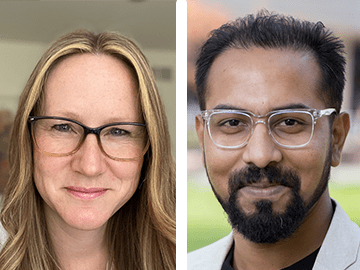Posted By: Sara Cullinan, PhD, Deputy Editor, AJHG

Each month, the editors of The American Journal of Human Genetics interview an author of a recently published paper. This month we check in with Cristen Willer and Tanmoy Roychowdhury to discuss their paper, Regulatory variants in TCF7L2 are associated with thoracic aortic aneurysm.
- What prompted you to start working on this project?
CW: The University of Michigan has a clinical research focus on aortic aneurysm, and we’ve been fortunate to have patients who care about helping us research this disease. These patients have provided a DNA sample and consented to us using their health records. Because of these dedicated research participants and our clinical faculty who treat their disease, the University of Michigan has created one of the world’s largest biobanks for thoracic aortic aneurysm and dissection. Because this disease can be so catastrophic to patients and their families, we fast-tracked our genetic studies of aneurysm.
- What about this paper/project most excites you?
TR: We still lack knowledge about genetic etiology of the ~80% thoracic aortic aneurysm cases that are not caused by pathogenic variants in single genes. Prior to this work, our success of identifying disease-associated genes using common genetic variants had been limited for this disease. We’re quite excited that alongside finding a new gene, we were also able to test a hypothesis about functional mechanisms leading to a relevant cellular phenotype. Also, we came across a gene TCF7L2, that is known to play a role in several other diseases, including diabetes and cancer; this points toward extensive pleiotropy.
- Thinking about the bigger picture, what implications do you see from this work for the larger human genetics community?
TR: Deciphering the disease-related biological functions following a genetic association remains a challenging task as associations are frequently observed in noncoding regions of the genome, which only gives us an approximate location of the actual genes involved. In addition to progress in the specific disease area, this work adds to the growing list of literature where we have some clue about the underlying biological basis, including which variant or gene is causal. As with other studies, this is now possible due to the enormous advancement over the years the scientific community made in annotating the human genome. - What advice do you have for trainees/young scientists?
CW: Work on important problems that matter to you — the plus side of being an academic researcher is the freedom to study important problems and really contribute to making the world a better place. Get as much training in statistics, coding and bioinformatics as possible. You can work with good scientists who are also nice people. You can manage work-life balance by prioritizing what’s important to you and cutting back on the rest. If you have to move away from your family of origin, negotiate time to see them. Build your own relationships with mentors – project mentors, career development mentors, work-life balance mentors. Don’t be afraid of sending cold emails to people – ask about their grants, research, to meet for a coffee. Most people are flattered to be asked for advice or to see their work. Before joining a lab, always speak to people who previously worked with them. Writing a grant is actually fun if you aren’t on a super tight deadline. If you want to be a PI, expect to spend substantial time learning how to manage people and finances, learn professional-level science communication (writing, talks, etc.) to ensure your research is impactful, and build your reputation as a fair person who does good science and asks important questions. Check authorship on your papers at multiple stages to ensure you didn’t miss anyone who contributed. Try not to compare yourself to others, instead ask if you are using your talents, skills, and energy to do good (science) to make a better world.
- And for fun, tell us something about your life outside of the lab.
CW: I grew up in Canada, went to grad school in England, and I’m now American. I’m a mom of 5, first and foremost. I looked after my kids’ needs first and work had to fit itself in around my other commitments and priorities. My personal interests are traveling, seeing my extended family as much as possible, genealogy, finding fun or unusual experiences, and walking my black lab. With my kids I love watching them do what they love (sports, interests, etc.) and documenting our family with photographs and stories. I also love talking about science with them.
TR: I’m a Bengali from Kolkata. In the Bengali language we have a word called “Adda” that roughly means getting together with a group of people to have long, fluid conversations about life, politics, sports, science etc. (it could be anything under the sun, to be honest), often accompanied by tea. Like many Bengalis from Kolkata, this is the most fun way to spend time outside the lab for me.
Dr Cristen Willer is a Professor in the departments of Internal Medicine, Human Genetics, and Computational Medicine & Bioinformatics at the University of Michigan. She is the recipient of the 2021 ASHG Early Career Award.
Twitter: @cristenw
Dr Roychowdhury is a postdoctoral fellow at the University of Michigan.
Twitter: @TanmoyRoychow13
